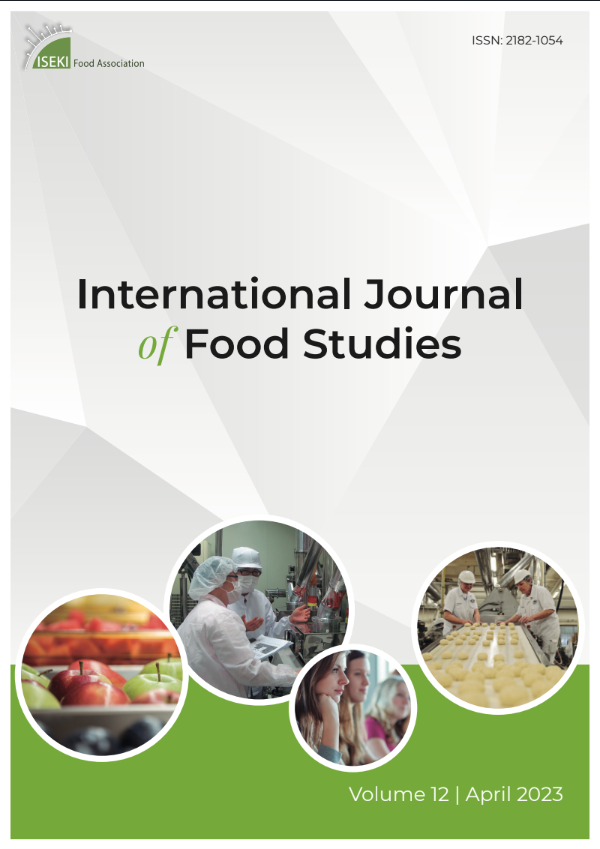Current issue

Volume 13, Issue 2, 2024
Online ISSN: 2182-1054
Volume 13 , Issue 2, (2024)
Published: 18.10.2024.
Open Access
All issues
Contents
01.12.2018.
Professional paper
Development and incorporation of nanoemulsions in food
Antonio de Jesus Cenobio-Galindo, Rafael G. Campos-Montiel, Rubén Jiménez-Alvarado, Isaac Almaraz-Buendía, Gabriela Medina-Pérez, Fabián Fernández-Luqueño
01.12.2018.
Professional paper
Effect of osmotic drying on physicochemical properties of pansies (viola × wittrockiana)
Luana Fernandes, Susana Casal, Agostinho Magalhães, Paula Baptista, José A. Pereira, Jorge A. Saraiva, Elsa Ramalhosa
01.12.2018.
Professional paper
Effect of chestnut and acorn flour on wheat / wheat-barley flour properties and bread quality
Marie Hrusková, Ivan Svec, Ivana Kadlcíková
18.04.2019.
Original scientific paper
Nutritional and antioxidant potential of rice flour enriched with kersting’s groundnut (Kerstingiella geocarpa) and lemon pomace
This study was designed to enhance the nutritional quality, antioxidant properties and product utilization potentials of locally produced ‘Igbemo’ rice flour by adding Kersting’s groundnut and lemon pomace. Kersting’s groundnut is an underutilized legume while lemon pomace is a byproduct of lemon utilization; both meant to enhance the protein quality, antioxidant potential and fibre contents of the composite flour. The dependent variables were minerals composition, amino acid profile, antioxidants and antinutrients properties, in-vitro protein digestibility and in-vitro carbohydrate digestibility. The result showed that blends with higher lemon pomace of 10.00 g had the best calcium, iron, potassium and magnesium contents and antioxidant contents, while blends with highest Kersting’s groundnut (20.00 g) had the best zinc content. The anti-nutrients in the blends were generally low and safe for consumption.
Olugbenga Awolu, Magoh A. Osigwe
01.12.2018.
Professional paper
Effects of “starch:water” ratio on gelatinization of pinhão starch from nine germplasm collections, measured by Differential Scanning Calorimetry
Camila D. Bet, Rossane C. B. Godoy, Layse P. Cordoba, Ivo M. Demiate, Luiz G. Lacerda, Egon Schnitzler
18.04.2019.
Original scientific paper
Moisture sorption isotherm and thermal characteristics of freeze-dried tuna
Water activity is considered an important factor in assessing the stability of food. Understanding the relationship between water activity and equilibrium moisture content (moisture sorption isotherm) benefits food processing in terms of modeling of drying and estimation of shelf life. In addition, glass transition helps to quantify molecular mobility which helps in determining the stability of food. The aim of this study was to determine the moisture sorption isotherm and thermal characteristics of freezedried tuna. These characteristics will help in determining the monolayer moisture and glassy state of the product, at which food is considered most stable. Moisture sorption isotherm at 20 oC and thermal characteristics (over a wide temperature range i.e. from -90 to 250 oC) of freeze-dried tuna flesh were measured. Isotherm data were modeled by BET (Brunauer-Emmett-Teller) and GAB (GuggenheimAnderson–De Boer) models. The GAB and BET monolayer water values were determined as 0.052 and 0.089 g g−1 dry-solids (dry-basis), respectively. In the case of samples at moisture contents above 0.10 g g−1 (wet basis), DSC (Differential Scanning Calorimetry) thermograms showed two-step state changes (i.e. two glass transitions), one exothermic peak (i.e. molecular ordering) and another endothermic peak (i.e. solids-melting). However, the sample at moisture content of 0.046 g g−1 showed three-step state changes (i.e. three glass transitions). The multiple glass transition could be explained by the natural heterogeneity of tuna flesh and inhomogeneity due to molecular incompatibility of the different compositions. The moisture content did not affect the first glass transition temperature nor the exothermic peak (p>0.05), whereas the third glass transition temperature decreased (i.e. plasticized) with increasing moisture content (p<0.05). The solids-melting peak temperature decreased, and enthalpy increased with decreasing moisture content (p<0.05).
Mohammad Shafiur Rahman, Mohammed Al-Khusaibi, Kutaila Abbas AL-Farsi, Ismail Mohamed Al-Bulushi, Aisha Abushelaibi, Nasser Al-Habsi
18.04.2019.
Original scientific paper
Moisture sorption isotherm and thermodynamic properties of jamun (Syzygium cumini L.) powder made from jamun pulp and seed
The present work aimed to: i) find the suitable proportion, based on sensory evaluation, of microwave-convective hot air dried jamun (Syzygium cumini L.) pulp and seed kernel powder to be mixed for the preparation of jamun powder (JP); ii) generate and model the moisture sorption isotherm (MSI) of JP; and iii) estimate net isosteric heat of sorption (qst), spreading pressure (Φ), net integral enthalpy (Qin), and net integral entropy (Sin). To formulate JP, the proportion (w/w, db) comprising 2% kernel and 98% pulp powder was the most desirable. The Peleg model was the best fit to MSI of JP. The qst decreased following linear relationship from 11.02 kJ. mol−1 at 5% equilibrium moisture content (EMC) to 0.27 kJ. mol−1 at 30% EMC. The Φ increased with increase in water activity and decreased with increase in temperature from 25 oC to 35 oC, and the values of Φ at 45 oC were even higher than at 25 oC. Net integral enthalpy (Qin) initially decreased till 6% moisture content in JP and displayed an increasing trend with further increase in moisture content. On the contrary, Sin kept on decreasing continually with increasing moisture content. The moisture zone of 7-11% was considered safe for storage of JP within the temperature range of 45-25 oC.
Indira Dey Paul, Madhusweta Das
18.04.2019.
Original scientific paper
Study of the self-stabilization ability of Tzatziki (a traditional Greek ready-to-eat deli salad)
Traditional Greek yogurt-based salad Tzatziki is one of the most popular ready-to-eat deli salads in Greece. The objective of this study was to estimate the microbial stability of Tzatziki, with and without chemical preservatives, using a rapid method. Determination of the microbial count was carried out using the bioluminescence method (ATP) and traditional microbiological analysis, plate-counting method (CFU) in various batches of the final product of Tzatziki. The results showed that the Tzatziki salad without preservatives initially gave higher relative light units (RLU) values (79,532) than the same salad with preservatives (43,198) because the potassium sorbate and the sodium benzoate, used the in recipe, appeared to suspend the action of microorganisms. After incubation in two different substrates, MacConkey and Sabouraud, the Tzatziki salad without preservatives gave higher RLU values (9,488 and 16,176, respectively) than the salad with preservatives (12,780 and 12,005, respectively). In the two selective substrates, differences appeared between the two methods of microbial count (RLU and CFU). While RLU values were roughly at the same level, the CFU values presented significant differences (p < 0.05). It was also shown that there was a strong correlation (R 2 = 0.93-0.95) between bacterial counts estimated by traditional CFU and ATP methods. As expected, the dominant microbial population in Tzatziki was Lactobacillus spp., originated from yogurt. Coliforms and yeasts were not able to survive in this environment. Generally, according to the results, Greek traditional Tzatziki salad was a microbial stable product and the bioluminescence method could be a rapid method to determine its microbial state.
Stavros Lalas, Vassilis Athanasiadis, Ioanna Karageorgou, Eleni Bozinou, Vassilis G. Dourtoglou
18.04.2019.
Original scientific paper
Effect of chestnut and acorn flour on wheat / wheat-barley flour properties and bread quality
Additions of barley flour alone or with combination of chestnut and acorn flour (30%; 30+5%; 30+10%) were aimed at increasing the dietary fibre content in wheat bread. In this regard, enhancement by acorn flour elevated the dietary fibre by a greater extent (up to 7.80%) compared to barley or chestnut flours. Increasing the proportion of non-traditional raw materials also influenced flour pasting properties during the amylograph test as well as the farinograph and extensigraph properties of nonfermented dough. In contrast to the wheat flour, analysis of Falling Number and Zeleny values showed a decrease in technological potential of flour composites of approximately 30%. Water absorption increased about 2 percentage points, mainly with enhancement by chestnut flour. All the non-traditional raw materials slowed dough development, whilst dough softening degree differed according to actual composition. Dough viscous and elastic properties worsened as shown by a decrease of in energy absorbed, depending on the type and the addition of the non-traditional products. Changes in flour composition were reflected in amylograph viscosity maximum, which became lower with increasing amounnts of chestnt and acorn flour. A significant worsening of the bread specific volume as well as of bread shape (vaulting) corresponded with a partial dilution of the gluten matrix. Compared to the wheat bread, 10% chestnut flour caused bread size to diminish to less than one half of the wheat loaf. Statistically, the principal features were water absorption, dough softening degree and extensigraph energy together with specific bread volume. In terms of wheat flour and bread quality, the influence of barley flour overcame the effects of adding chestnut or acorn flours.
Marie Hruškova, Ivan Svec, Ivana Kadlčikova, Marie Hruškova
18.04.2019.
Original scientific paper
Physico-chemical composition and antimicrobial protein content of early lactation donkey milk
The influence of early lactation on chemical composition and the concentration of antimicrobial proteins of donkey’s milk produced in Cyprus were investigated. Milk samples from 10 female donkeys in their first season of lactation were collected at 7, 15 and 30d postpartum. The average contents of donkey milk gross composition were 1.40% protein, 0.16% fat and 8.74% total solids. Results showed that lactation had a significant negative effect on protein concentration, while total solid concentration showed an increased followed by a decrease. Composition of antimicrobial proteins also showed a significant decreased during lactation period except from lactoferrin which showed an increase. On the other hand, throughout the lactation, pH and fat were constant.
Maria Aspri, Kallis Souroullas, Christina Ioannou, Photis Papademas











